Geo-environmental Assessment of Al-Ramtha Soils, Jordan
Saeb Al- Shereideh1 , Mohammad Wahsha2 , Nazem El- Radaideh1 , Ahmed A. Al-Taani1,3 , Nabeel Abderahman1 , Sanaa Odat1 , Talal Al- Momani1 and Mohammad Khawajah1
1
Department of Earth and Environmental Sciences, Faculty of Science,
Yarmouk University,
Irbid,
Jordan
2
Marine Science Station,
The University of Jordan and Yarmouk University,
Aqaba,
Jordan
3
UNESCO Chair for Desert Studies and Desertification Control,
Yarmouk Univeristy,
Irbid,
Jordan
DOI: http://dx.doi.org/10.12944/CWE.10.2.03
This study aims to characterize the pollution conditions by measuring the concentrations of selected heavy metals. It also intends to investigate the relations between soil genesis and lithology. This provides knowledge about the future of the agricultural development in the area and helps decision makers in the land use planning.
Copy the following to cite this article:
Al- Shereideh S, Wahsha M, El-Radaideh N, Al-Taani A. A, Abderahman N, Odat S, Al- Momani T, Khawajah M. Geo-environmental Assessment of Al-Ramtha Soils, Jordan. Curr World Environ 2015;10(2) DOI:http://dx.doi.org/10.12944/CWE.10.2.03
Copy the following to cite this URL:
Al- Shereideh S, Wahsha M, El-Radaideh N, Al-Taani A. A, Abderahman N, Odat S, Al- Momani T, Khawajah M. Geo-environmental Assessment of Al-Ramtha Soils, Jordan. Curr World Environ 2015;10(2). Available from: http://www.cwejournal.org/?p=12014
Download article (pdf)
Citation Manager
Publish History
Select type of program for download
| Endnote EndNote format (Mac & Win) | |
| Reference Manager Ris format (Win only) | |
| Procite Ris format (Win only) | |
| Medlars Format | |
| RefWorks Format RefWorks format (Mac & Win) | |
| BibTex Format BibTex format (Mac & Win) |
Article Publishing History
| Received: | 2015-05-24 |
|---|---|
| Accepted: | 2015-07-26 |
Introduction
Soils are fundamental components of the ecosystem, the backbone of terrestrial ecosystems and contribute in several biogeochemical processes at air, soil and water Interfaces. Soils can absorb and degrade many types of extremely toxic substances (ETS) such as heavy metals. However its capacities are limited and sometimes may become contaminated (Wahsha et al., 2014a). Therefore, the soil quality and its productive capacity must be preserved and improved. The levels and spatial distribution of ETS in soils depend on several factors such as parent material, climate, topography, soil type and land use (Wahsha et al., 2012a). Three main sources of pollution can be identified: industrial activities and agricultural practices. The mismanagement of these anthropogenic activities could strongly increase the normal concentration level of ETS in soils, causing contamination, environmental troubles and health concerns. Soil contamination by heavy metals may influence negatively soil health, which often limits and sometimes disqualifies soil biodiversity and decreases plant growth (Nadimi-Goki et al., 2014). Within soils, all biological, geological and chemical processes of the different ecosystem components are combined (Maleci et al., 2014). A common criterion to evaluate long term sustainability of ecosystems is to assess the quality of soil (Wahsha at al., 2014b).
Therefore it is important to understand the soil composition, properties and dynamics to make sustainable protection and reclamation if required. There is a growing need to apply more sustainable and geo-environmental assessment to soils which may become or have become polluted (Wahsha et al., 2014c).
The major characteristic of the climate in Jordan is the contrast between sub-humid Mediterranean in the northwestern and arid to extremely arid in the east and southeastern Jordan. In addition to altitudinal and geologic variations, these factors have played a major role in soil development and genesis (Wahsha et al., 2014b). Soil Survey in Jordan dates back to 1950s using the US classification system of 1938 (Al-Qudah, 2001). In northwestern Jordan, five are common; Aridisols, Entisols, Inceptisols, Vertisols and Mollisols (Ministry of Agriculture, 1993). These soils have been developed from different parent materials including Quaternary alluvium, colluvium and loess deposits (Khresat et al. 1998).
The study area is the eastern extension of the northern plateau; a fertile soil known for cereal planting. It is actually of less productivity compared to soils of the western part. However, in the last few decades, this area has observed rapid expansion in urban development. The area hosts a major highway between Irbid and the eastern cities including Al-Ramtha, which facilitated the eastward expansion of human settlement. Soil in northeastern Jordan is mainly of Aridisols order, where it was developed under conditions of low rainfalls and high temperatures. Soils cover about 70% of the study area with a moisture regime of xeric aridic transition (Khresat et al. 1998).
This study aims to characterize the pollution conditions by measuring the concentrations of selected heavy metals. It also intends to investigate the relations between soil genesis and lithology. This provides knowledge about the future of the agricultural development in the area and helps decision makers in the land use planning.
Study area
The study area is located in the northern part of Jordan, about 2 km south of Al-Ramtha city (east of Irbid) between 32°31'- 32° 32' longitude and 35º59'-36º3' latitude (Fig. 1). The main geologic outcroppings in the study area are: Muwaqqar Chalk Marl Formation (B3) which is composed of marl and marly limestone, and Umm Rijam Chert Limestone Formation (B4) of lower–middle Eocene age. The B4 Formation is mainly composed of alternations of limestone, chalk and chert. Holocene calcrete occurs in limited parts within the study area (Fig. 2). The calcrete is randomly distributed in different parts of semi-flat and gently sloping plains, where evaporation exceeds annual rainfall. Most rocks in this area are covered with soil of variable thicknesses that range from 1-6 m. This soil was developed by weathering of the carbonate rocks exposed in the surrounding area (Abed, 2003; Ministry of Agriculture, 1993).
Materials and Methods
The area under consideration in this study is located in Al-Ramtha city. Seven sites were selected according to homologous geological, morphological, vegetation coverage and anthropogenic impact and the same pedoclimate conditions (Fig. 1). Each site was sampled at 5, 15 and 30 cm depths. Samples were tightly wrapped with aluminum foil and placed in sealed plastic bags to preserve soil moisture content. Once carried to the lab, routine soil analyses were carried out following the procedures described by Wahsha et al. (2012b). Samples were initially analyzed for moisture content, and grain size distribution to determine soil texture. Soil samples were also subjected to mineralogical analysis involving x-ray diffraction. The XRD analysis for random samples was accomplished using Phillips TW 1729 diffractometer with Cu-K-alpha radiation generated at 40 kV and 20mA. The samples were crushed gently using a wooden rod in order to separate the grains without damaging the crystal lattices. One sample from each sampling site was analyzed for XRD. In addition, soil samples were oven-dried at 105°C for 24 hours, extracted with deionized water (1:5 soil-to water mixtures), shaken for 90 minutes, centrifuged and filtered through a 0.45 micron filter. The extract was analyzed for NO3- and PO4-3 (by spectrophotometer), EC and pH. The bulk chemical composition of the samples was determined using both atomic absorption spectrophotometery (AAS) and gravimetric method.
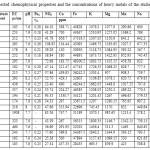 |
|
For the analysis of pseudo-total metal content (Cu, Fe, K, Mg, Mn, Na, Pb and Zn) in soils, 0.2 g of powder soil sample was subjected to a complete digestion in 5 mL of aqua regia in the microwave in closed containers made of Teflon. After digestion, soil samples were analyzed by flame atomic absorption spectrometry (AAS) according to Fontana et al. (2010).
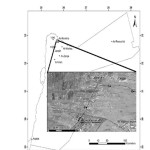 |
Fig. 1: Location of the studied area and sampling sites Click here to View figure |
Results and discussion
Origin of surface soils
The grain size distributions of most hydraulic and aeolian soils are considered are polymodal and represent different transport or depositional processes (Bagnold and Barndorff-Nielsen, 1980). Grain-size distribution of collected samples has been commonly used as environmental indicators in soil investigations.
Most of coarse grained soils; particularly sand and gravel deposits in the studied area were transported hedonically during storm wet years as result of flash flood due to wide spread of caliches areas deposits (Fig. 2).
The results of the textural analysis of surface soils are tabulated in Fig.3. Grain size distribution suggests granulometric distribution of the surface were concurrent with distribution of fine and medium grained material, as found in similar flat systems. vast majority of soils showed silty, sandy, clay and pebbly textural granular facies.
These sediments were deposited in the flat watercourse basin. average grain size increases in the north direction, where deposition of the coarser fraction took place. It is likely that sand was transported by saltation, while silt and clay were transported by suspension in the water or by wind action. The pebbly facies is believed to have been deposited after the heavy rains or storm events (Fig. 2).
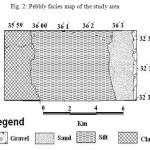 |
Fig. 2: Pebbly facies map of the study area Click here to View figure |
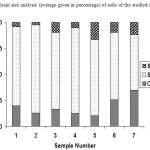 |
Fig. 3: Grain size analysis (average given in percentage) of soils of the studied area. Click here to View figure |
Geochemistry
The mean concentrations and standard deviations of the chemical properties and metals concentration for all studied samples are shown in Table 2. In the area of investigation, moisture content of soil samples varied from 7.6-30.8% (averaging about 18.97(Table 2).
Table2: The average concentrations of heavy metals in the earth's crust (Rule, 1986) and in soil (ppm) (Adriano, 2001), and normal range in soils and critical soil total concentration (Alloway, 1990), compared with the results obtained from the analyzed soil samples.
|
Metal |
Ave. crustal abundance |
Normal range in soils |
Critical soil total conc. |
Average world soil |
Soil in the study area |
|
Pb |
12.5 |
2-300 |
100-400 |
20 |
145.56 |
|
Zn |
70 |
1-900 |
70-400 |
95 |
116.16 |
|
Cu |
70 |
1-20 |
2-100 |
45 |
330.79 |
|
K |
- |
- |
- |
96600 |
1353.33 |
|
Fe |
- |
- |
- |
47200 |
38996.14 |
|
Mn |
- |
20 -10000 |
1500-3000 |
850 |
684.16 |
|
Na |
- |
- |
- |
9600 |
671.47 |
|
Mg |
- |
- |
- |
1500 |
1157.25 |
The pH values of the collected soil samples ranged from 7.2 to 8.2 with a mean value of 7.75. These values indicate that the soil is of slightly alkaline nature. The higher pH> 7 plays a role in the removal of metals from aqueous to solid phase and in the plant availability of nutrients. Adsoprtion-desorption are primarily dependent on pH, for example; it was observed an increase in the adsorption of lead by soil with the increasing of pH from 4 to 7. Generally, heavy metals concentrations in the studied soil are relatively high which could be explained by the increasing of pH (> 8) which increases the ability of soil to adsorb these elements (Nadimi-Goki et al. 2014).
The nitrate content (NO3) of the soil samples ranged between 27 and 108 ppm with an average of 53 ppm (Table 2). The nitrogen concentration increase could be due to the decay of plants residues or from irrigation with treated wastewater. The increased usage of nitrogen fertilization and manure application in the adjacent cultivated lands as well as effects of man and livestock wastes also attribute to the increase in NO3-.
In the analyzed samples electrical conductivity (EC) ranged from 174 µs/cm to 1908 µs/cm with a mean of 334.14 µs/cm (Table 2). The variation in EC values can be explained, as being due to the source of irrigation water, where irrigation with treated wastewater resulted in significantly higher values for EC. The use of pesticide Pyrozone which contain Zinc ethylene, Diyathogarbmite and Seymezal with 88% viscous sulfur content and the use of Ammonic (NH4 ) SO4-- fertilizer , may explain the increase in EC (Abu- Rukah and Samawi, 2000).
The soil content of phosphate (PO4) ranged between 5.78% and 34.86%, with an average content of 12.96 (Table 2). The variation in soil PO4 is attributed to variation in agricultural intensity in the study area. The upper-Cretaceous phosphate in the surrounding, is another contributing cause to the PO4 content in soil. The continuous use of phosphate fertilizers in agricultural land are another source of the phosphate in the study area (Bini and Wahsha 2014).
Nitrate has been observed in relatively high levels, although soils in the study area are devoid of vegetation cover. Despite the variability in nitrate levels, general trends are apparent. The results showed that at each location, nitrate level decreases with depth (Fig. 3).
Heavy metal concentrations
The concentration of Pb and Zn in the soil samples ranged from 70 to 207 ppm with a mean value of 146 ppm and from 0.0 to 465 ppm with a mean value of 116 ppm, respectively, whereas the mean concentration of Cu, Fe, K, Mg, Mn and Na were 330, 38996, 1353, 1157, 684 and 671 ppm respectively (Table 2).
The variation in the content of Pb, Zn, Na, Cu, Mn, Mg, K and Fe in the soil of the study area makes it difficult to analyze their degree of contamination without taking into account the spatial variability of metals and their content in different world average values. Table 3 shows the average concentrations of heavy metals in the earth's crust in soil (Rule, 1986; Adriano, 1986), normal range in soils and critical soil total concentration (Wahsha et al., 2012b; Alloway, 1990), compared with the results obtained from the analyzed soil samples collected in the study area.
Almost all the locations show high concentrations in various metals in the soil of the study area which exceed the permissible level stated in Mason Moore, 1982. The sources of this increase in the various metal ion concentration could be attributed to the increasing anthropogenic effect from agriculture sources, in addition to the contribution of the natural source.
Lead pollution in the environmental samples including soil, dust, sediment and natural water comes from combustion of gasoline that contains tetraethyl lead as an anti-knock agent. Lead concentrations greater than 110 for the total lead content should not occur naturally in soils and must probably reflect the impact of pollution (Kabata-Pendias and Pendias, 1984). According to Bender, (1991), the soils of the study area were : mainly originated from the upper cretaceous carbonate rocks found in the. But carbonates in general have low concentrations of lead. Comparing this with the values obtained in this study, it is clear that the carbonate parent rocks are not the only source of lead. Other sources contribute most likely anthropogenic ones (Wahsha and Al-Rshaidat, 2014).
The average concentration of Zn in carbonate rocks (Table 3) is about 20 ppm. Alloway (1990) estimated the average concentration of zinc in the carbonate rocks as 20 ppm. and the average concentration, of zinc in normal soil ranges from 1 to 900 ppm. Kabata-Pendias and Pendias, (1984) has found that the average zinc concentration lies between 17 and 125 ppm. Comparing the average concentrations of zinc in the soils of the study area with those given by several authors, it seems that the relatively higher values of zinc concentrations in the analyzed soil samples may reflect anthropogenic effects (Wahsha and Al-Rshaidat, 2014). This may explain the relatively high concentrations of Zn in the soils of the study area.
Higher concentration of copper in the surface horizon of a soil is an indication of soil additions from smelters, fertilizers, sewage slugs and other wastes, (Allowey, 1990). The levels of copper in the samples were higher than the world-wide values (100 – 300 ppm) (Fergusson and Kim, 1991). The present study found that copper levels were high compared with several regions or areas in the world (Table 3). By analyzing the average concentration of Na, Mn, Mg, K and Fe in the in the study area, it seems that these contents are similar with those reported by Kabata – Pendias (1984).
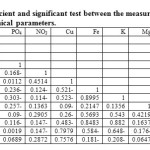 |
Table 3: Correlation coefficient and significant test between the measured heavy metals and associate physico-chemical parameters. Click here to View table |
Correlation analysis
The measured total concentration of the heavy metal was positively correlated with the measured physio-chemical properties. The positive correlation between the heavy metal contents and the % PO4 may be attributed to the use of the phosphate fertilizers in the area under study, which is characterized by intensive agricultural activities.
Alloway et al., (1995) showed that pH was one of the key factors controlling the specific adsorption of heavy metals in different soils. Positive correlation of heavy metals in the sediments is strongly related to the alkalinity of pH (Alloway, 1990, Baker, 1980).
Nitrate has been observed in relatively high levels, although soils in the study area are low of vegetation cover. Despite the variability in nitrate levels, general trends are apparent. The results showed that at each location, nitrate level increased to a depth of 15 cm where it remained almost constant afterward.
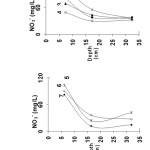 |
|
The semiarid climate conditions of the study area with its relatively limited rainfall allow nitrate to accumulate near the surface. However, over a long period and during events of rainfall, nitrate leaches into soil and accumulates as water evaporates and returns to the atmosphere. In addition, grain size distribution of soil samples (Table 1) showed that soil samples are composed mainly of silt and clay with minor proportion of fine sand. These fine particles can be closely packed together and decrease water infiltration and favor accumulation of nitrates by evaporative concentration. While sources of nitrate have not been investigated, it is believed that both processes; biological or no biological, contribute to soil nitrate. The study area is in a transition zone between arid (eastwards) and sub humid (westwards) and is subjected to dust and sand storm particularly the frequent easterly wind. This suggests that portion of these nitrates is likely associated with aeolian deposits, where nitrate has been transported with atmospheric influx to the area. In addition, the area is covered with scattered native vegetation which releases nitrate when decomposed. The presence of scattered vegetation also helps trap aeolian dust containing nitrates, which leaches into soil. The soil pH for all samples exhibited alkaline soils, which is mainly related to the presence of calcium carbonate. In addition, the arid and semiarid climate conditions prevailing in the study area help buildup of carbonate in soil profile (Wahsha et al., 2012a and b; Fontana et al., 2010).
The relation between Soils and Clay content
The soil textural classes depend on the percentage of clay, silt and sand in the soil. Clays are soil particles less than 2μm in size, having a higher surface area than other soil particles like sand and silt. In most cases this specifically includes the clay minerals, but also fine grinded particles of other minerals. Clay minerals are the products of weathering rock and affect both soil physical and chemical properties. Soil chemical properties are impacted by their permanently negatively charged, large surface area. Since much of the cation exchange capacity of soils comes from the negatively charged clay surface sites, clayey soils renders metals much less available than sandy soils. Clay minerals may contain small amounts of trace elements as structural components, but their sorption capacities to trace elements play a very important role. The sorption capacities of different clay minerals vary in the following sequence: montmorrilonite, vermiculite > illite, chlorite > kaolinite (Wahsha and Al-Rshaidat, 2014).
XRD and Organic Matters
Clay minerals such as kaolinite and Fe-oxides are considered variable-charge minerals (Sparks 2002 and 2005). Heavy metals, including Lead (Pb), tend to accumulate in the clay fraction of the soil profile. The Zn concentration in the soil and clay content are positively correlated (Hailu, 2007). Total concentration of heavy metals (Co, Cu, Ni, Pb, and Zn) in soils is dependent on clay content. There are fivefold more Cu, two fold more Zn and Ni, and 1.5-fold more Co and Pb in the clay fraction than in the total soil. The clay fraction of surface horizons contains a greater concentration of Cu, Zn, and Co than subsoil horizons due to biogeochemical cycling of these micronutrients from the subsoil to the surface (Lee et. al, 1997).
A general look for the concentrations of some major and trace elements for soil samples at various locations and different depths (Fig. 4) shows that; the concentrations for trace elements are increased with depth at A, B and C locations, while the concentrations are decreased at D, E, F and G locations; this may controlled by the amount of rainfall and the percentage of sand comparing to silt and clay at these areas. Areas that have more annual rainfall cause more heavy elements leaching and cause accumulation at greater depth and vice versa, beside the percentage of sand comparing to silt and clay at locations D, E, F and G, relatively more than the percentage at the locations A. B, and C, this make easier infiltration of water and so transport of heavy elements to greater depth.
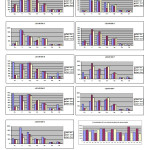 |
|
Conclusions
Soil is a fundamental, poorly renewable resource, which provides a number of environmental, social and economic services. Instead, the major short term impacts on soil functioning derive from land use change and its management. The anthropogenic impact in the selected site is evident. Almost all the locations show high concentrations in various metals in the soil of the study area which exceed the permissible levels. The sources of this increase in the various metal ion concentration could be attributed to the increasing anthropogenic effect from agriculture sources, in addition to the contribution of the natural sources in the area.
Acknowledgment
This work has been funded by the Deanship of Scientific Research and Graduate Studies at Yarmouk University, Jordan.
References
- Abed, A M. Geology of Jordan: Al Nahda Al Islamiah Library, Amman, Jordan 460p (2003).
- Abu- Rukah, Y, and Samawi, M. A study of contamination of the Northen Jordan valley agricultural fields by various metal ions using regression analysis. Qatar Sci. J, 20:155 -165(2000).
- Adriano, C. Trace Elements in the Terrestrial Environment. Springer-Verlag New York Inc. pp 390-420(1986).
- Aide, Michael T. Cwick, Gary J.Elemental distributions in Eutric Brunisols from the northern glacial Lake Agassiz region of Manitob. Transactions of the Missouri Academy of , Annual (2002).
- udel.edu. Internet from 09 Feb 2010 12:00Am
- Al-Taani, A. A. and K. A. Al-Qudah. 2013: Investigation of desert subsoil nitrate in Northeastern Badia of Jordan. - Science of the Total Environment, 442: 111-115.
- Al Qudah, B. Soils of Jordan. In : Zdruli P. (ed.), Steduto P. (ed.), Lacirignola C. (ed.), Montanarella L. (ed.). Soil resources of Southern and Eastern Mediterranean Bari : CIHEAM, p. 127-141(2001).
- Alloway, B. J. Heavy metals in soils. Blackie Academic & Professionals, 368 pp(1995).
- Bagnold, R. A., and Barndorff-Nielsen, O. The pattern of natural size distributions. Sedimentolgy 27, 199 – 207(1980).
- Baker, K. Fundamentals of clay minerals. Baghdad University Press (1980).
- Banat, K. M., Howari, F. M., To'Mah, M. M. 2007. Chemical Fractionation and Heavy Metal Distribution in Agricultural Soils, North of Jordan Valley. Soil and Sediment Contamination, 16: 89-107.
- Bender, J., J.P., Gould, Y. Vatcharapijarn, and G. Saha. Uptake, transformation and fixation of Se(VI) by a mixed selenium-tolerant ecosystem. Wat. Air Soil Poll. 59: 359-367(1991).
- Bini, C., Wahsha, M. Potentially Harmful Elements and Human Health. Book Chapter in: Potentially harmful elements in the environment and the impact on human health. Editors: Claudio Bini and Jaume Bech. Publisher: Springer. pp 401-463(2014).
- Dominguez Gonzalez,R. Application of ultrasound assisted acid leaching procedures for major and trace elements determination in edible seaweed by inductively coupled plasmaoptical emission spectrometry", Talanta (2005).
- El Radaideh,Nazem Mansour. Sedimentological, Physiochemical and Environmental Evaluation of Reservoir Sediments: Case Study from Al Wala Dam, Central Jordan. EarthScience Research(2014).
- Fergusson, J. E., & Kim, N. D. Trace elements in street and house dusts: sources and speciation. Science of the Total Environment, 100, 125–150(1991).
- Fontana, S., Wahsha, M., Bini, C. Preliminary observations on heavy metal contamination in soils and plants of an abandoned mine in Imperina Valley (Italy). Agrochimica 54(4):218–231(2010).
- Joseph Sneddon. Sample Preparation of Solid Samples for Metal Determination by Atomic Spectroscopy—An Overview and Selected Recent Applications. Applied Spectroscopy Reviews,(2006).
- Hailu, A. Metal concentration in vegetables grown in North Addis Ababa and part of rift valley (Ziway), Ethiopia. M. Sc. Thesis, Addis Ababa University(2007).
- Kabata –Pendias A., and Pendias H. Biogeochemistry of trace elements.(in Polish)PWN Warszawa,pp 397(1984).
- Khresat, A., Rawajfih, Z., and Mohammed, M. Land degradation in north- western Jordan: Causes and processes. Journal of Arid Environments, 39, pp. 623-629(1998).
- Lee, B.D.; Carter, B.J.; Basta, N.T. and Weaver, B. Factors influencing heavy metal distribution in six Oklahoma benchmark soils. Soil Science Society of America. v. 61(1) p. 218-223(1997).
- Maleci, L., Buffa, G., Wahsha, M., Bini, C. Morphological changes induced by heavy metals in dandelion (Taraxacum officinale Web.) growing on mine soils. Journal of Soils and Sediments 14 (4), 731-743(2014).
- Ministry of Agriculture. National Soil Map and Land Use Project 1993. Level 1 Final Hunting Technical Services Ltd and Soil Survey and Land Research Center. Ministry of Agriculture, Amman, Jordan(1993)
- Nadimi-Goki, M., Wahsha, M., Bini, C., Kato, Y., Vianello, G. and Antisari, LV. Assessment of total soil and plant elements in rice-production systems in NE Italy. Journal of Geochemical Exploration 147, 200-214(2014).
- Sahawneh, Julia. "Structural Control of Hydrology, Hydrogeology and Hydrochemistry along the Eastern Escarpment of the Jordan Rift Valley, JORDAN. Universität Karlsruhe, (2011).
- Rule, J.H. Assessment of trace element Geochemistry of Hampton roads Habor and lower Chesapeake Bay area sediments. Environ. Geol.water.sci.Vol 8 .No 4., pp 209 -219(1986).
- Sun D, Bloemendal J, Rea DK, Vandenberghe J, Jiang F, An Z, Su R .Grain-size distribution function of polymodal sediments in hydraulic and aeolian environments, and numerical partitioning of the sedimentary components. Sedimentary Geology 152, 263–277(2002).
- Sparks, D. L. Toxic Metals in the Environment: The Role of Surfaces. ELEMENTS, VOL. 1 , PP . 193–197(2005).
- Sparks, D. L., 2002. Environmental Soil Chemistry. Academic Press, San Diego(2002).
- Wahsha, M., Fontana, S., Nadimi-Goki, M., Bini, C. Potentially toxic elements in foodcrops (Triticum aestivum L., Zea mays L.) grown on contaminated soils. Journal of Geochemical Exploration 147, 189-199(2014a).
- Wahsha, M., Al-Rshaidat, MMD. Potentially Harmful Elements in Abandoned Mine Waste. Book Chapter in: Potentially harmful elements in the environment and the impact on human health. Editors: Claudio Bini and Jaume Bech. Publisher: Springer. pp 199-220(2014).
- Wahsha, M., Bini, C., Argese, E., Minello, F., Fontana, S., Wahsheh, H. Heavy metals accumu- lation in willows growing on Spolic Technosols from the abandoned Imperina Valley mine in Italy. Journal of Geochemical Exploration 123:19–24(2014a).
- Wahsha, M., Bini, C., Fontana, S., Wahsha, A., Zilioli, .Toxicity assessment of contaminated soils from a mining area in Northeast Italy by using lipid peroxidation assay. Journal of Geochemical Exploration 113:112–117(2012b)
- Wahsha, M., Bini, C., Zilioli, D., Spiandorello, M., Gallo, M. Potentially harmful elements in terraced agroecosystems of NE Italy: Geogenic vs anthropogenic enrichment. Journal of Geochemical Exploration 144, 355-362(2014c).
- Wahsha, M., Nadimi-Goki, M., Bini, C. The impact of olive mill wastewater on the physicochemical and biological properties of soils in northwest Jordan. International Journal of Environmental Quality 15: 25-31(2014b).






